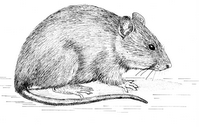 Today, December 5th …
Today, December 5th …The city of Paris was under siege by the Prussians between September 19th 1870 and January 28th 1871. The intention of Prussia was no different from any other besieging force throughout history – to force the enemy to heel by starvation. One Henry Labouchère - with the by-line “Besieged Resident of Paris” - regularly reported to the Daily News in England, his correspondence being forwarded by balloon or “by messengers who promised to 'run the blockade.' " His letters are a lively record of how the citizens of the City of Light dealt with the siege conditions, and in particular, how they coped with the increasing shortages of food.
On this day in 1870, his report read:
The following is a list of the prices of "luxuries" - Terrines of chicken, 16f; of rabbit, 13f; a fowl, 26f; a rabbit, 18f; a turkey, 60f; a goose, 45f; one cauliflower, 3f; one cabbage, 4f; dog is 2f. a lb.; a cat skinned costs 5f.; a rat, 1f., if fat from the drains, 1f. 50c. Almost all the animals in the Jardin d'Acclimatation have been eaten. They have averaged about 7f. a lb. Kangaroo, however, has been sold for 12f. the lb. Yesterday I dined with the correspondent of a London paper. He had managed to get a large piece of mufflon, an animal which is, I believe, only found in Corsica. I can only describe it by saying that it tasted of mufflon, and nothing else. Without being absolutely bad, I do not think that I shall take up my residence in Corsica, in order habitually to feed upon it.
Labouchère ate many of the things on the list as the siege progressed, and his narrative was sprinkled with throw-away phrases clearly designed to shock his English readers. He eats a salmi of rat one day, but notes that the proprietor of the restaurant’s “heart failed him” when the moment came to present the bill, and he wrote the name of the dish as salmi of game. He admits to a little guilt at eating “man’s best friend” when he eats “a slice of spaniel” one day, but another day determines that “cat served up for dinner is the right animal in the right place”.
M. Labouchère may have been underwhelmed by the Mouflon (a species of feral sheep thought to be one of the ancestors of the domesticated animal), but perhaps it was not cooked imaginatively. Surely any good Parisian cook could have prepared an entirely acceptable Haricot Mouflon from feral sheep flesh?
Rat or Cat would have been more of a challenge. What garnish would be appropriate? Today seems to be a good day to consider dishes styled “à la Parisienne”, does it not? According to the Larousse Gastronomique à la Parisienne refers to a garnish “the elements of which vary sometimes, but should always include Potatoes à la Parisienne” – a description which seems a bit circular. There does not appear to be absolute consensus on the details of the garnish, as you will see.
The description/recipe from Larousse is:
Potatoes à la Parisienne.
Like Noisette potatoes, but smaller in size. As soon as the potatoes are cooked, toss them in greatly concentrated veal gravy or dissolved meat jelly. Sprinkle with chopped parsley.
The interesting Baron Brisse, whose book “366 Menus and 1200 recipes” was published a couple of years before the siege, gives this method:
Potatoes à la Parisienne.
Chop up some onions very fine, and brown in equal quantities of butter and lard; when a good colour, moisten with either water or stock, add your potatoes, season with a bouquet of herbs, salt and pepper. When cooked, serve very hot.
A third version from an ocean away and a decade later is from Miss Parloa's New Cook Book (Boston Cooking School, 1882) . She makes them in the fashion of globular French fries:
Potatoes à la Parisienne
Pare large uncooked potatoes. Cut little balls out of these with the vegetable scoop. Six balls can be cut from one large potato. Drop them in ice water.
When all are prepared, drain them, and put in the frying basket. This can be half full each time—that is, about three dozen balls can be put in.
Put the basket carefully into the fat, the same as for thin fried potatoes. Cook ten minutes.
Drain. Dredge with salt, and serve very hot.
These are nice to serve with a fillet of beef, beefsteak, chops or game. They may be arranged on the dish with the meats, or served in a separate dish.
Tomorrow’s Story …
Encyclopaedic Food.
A Previous Story for this Day …
The story for December 5th 2005 was "The Long Experiment" - on the topic of Prohibition in the USA.
Quotation for the Day ...
Why is not a rat as good as a rabbit? Why should men eat shrimps and neglect cockroaches? Henry Ward Beecher.
1 comment:
Yes, I've read contemporary accounts of the Seige of Paris. Even Castor and Pollux, the pair of elephants, were not spared. I understand they were butchered and sold as 'boeuf de siège.'
Nene
Post a Comment